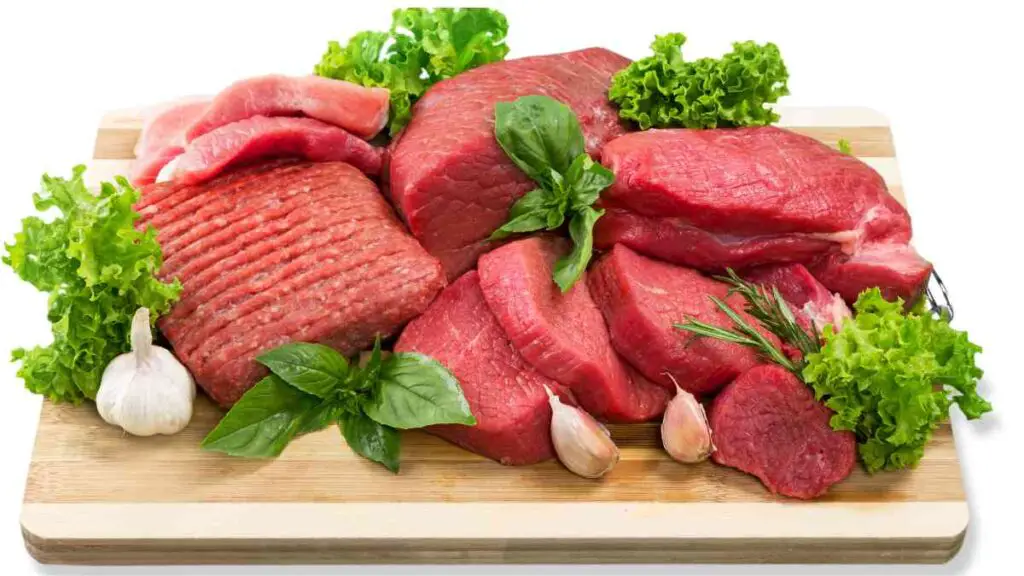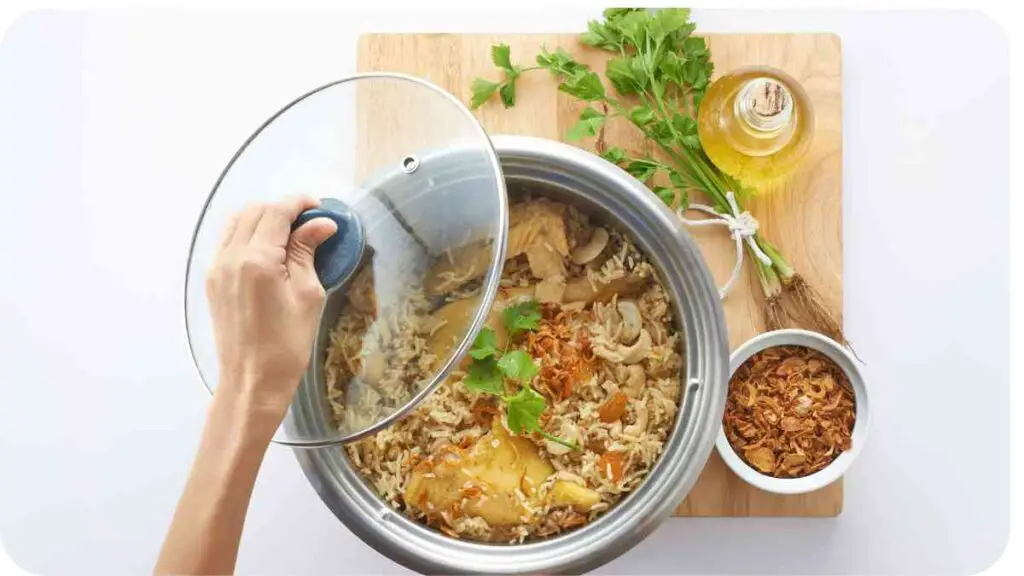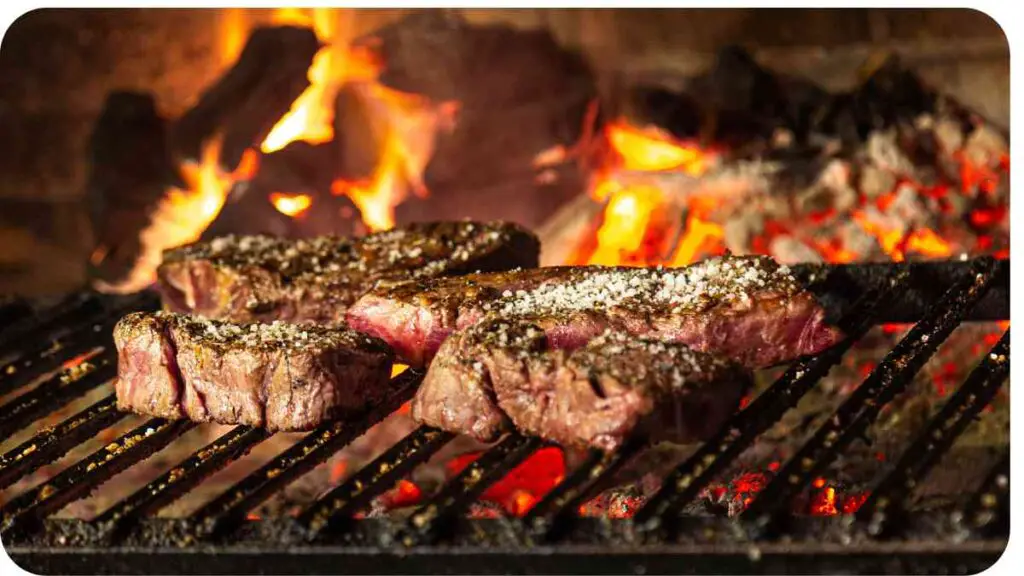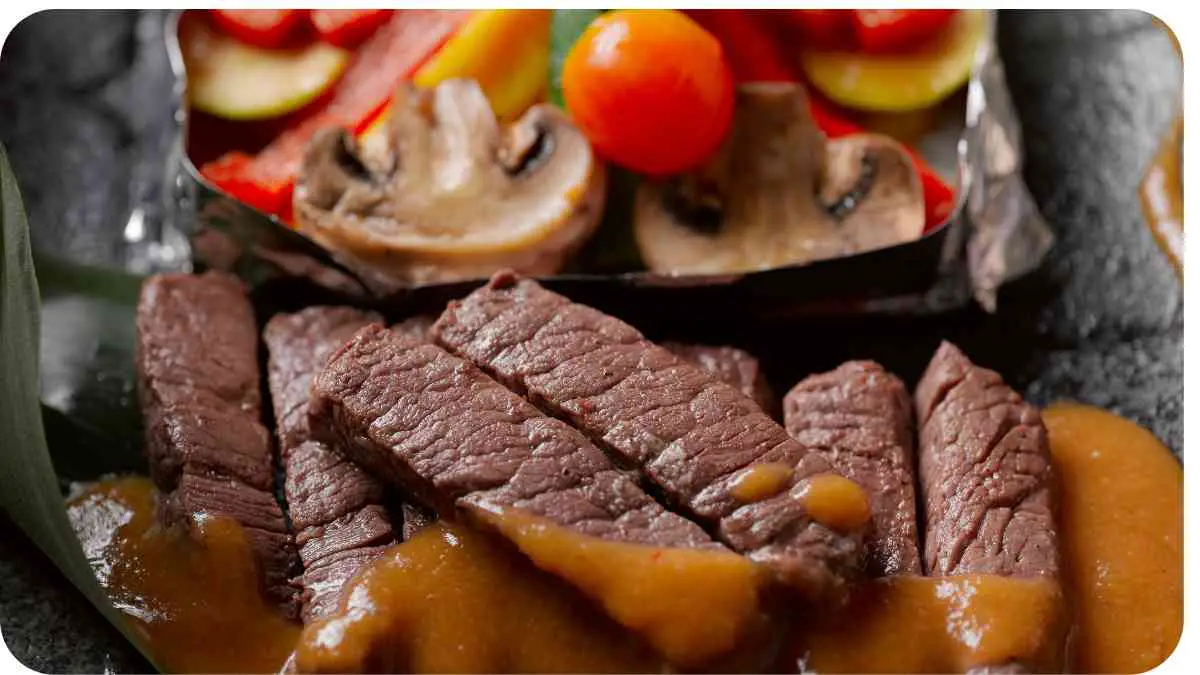Welcome to the fascinating world of meat preparation! Whether you’re a seasoned chef or a novice in the kitchen, understanding the science behind cooking meat can elevate your culinary skills to new heights.
In this comprehensive guide, we’ll explore the journey of meat from its raw form to perfectly cooked, delving into various aspects that contribute to flavor, tenderness, and overall dining satisfaction.
| Takeaway |
|---|
| Understanding the different types of meat and their unique characteristics is essential for successful cooking. |
| Marination is not only about adding flavor but also plays a crucial role in tenderizing the meat. |
| Balancing seasonings is an art that can elevate the taste of your meat dishes. |
| Different cooking methods, such as grilling, roasting, and searing, bring out distinct flavors and textures in meat. |
| Proper resting of meat after cooking is crucial for enhanced juiciness and flavor. |
| Equipping yourself with the right tools, including thermometers and grilling accessories, is key to mastering the art of cooking meat. |
| Troubleshooting common issues, such as overcooking and undercooking, requires a combination of techniques and proper tools. |
| Perfect pairings with sides and beverages can complement and enhance the overall dining experience. |
| Insights and tips from renowned chefs provide valuable guidance for achieving culinary excellence. |
| Exploring additional resources can deepen your understanding of the science behind cooking meat. |
2. The Basics of Meat

2.1 Types of Meat
Before we dive into the cooking process, let’s familiarize ourselves with the different types of meat available. From beef and poultry to lamb and pork, each type brings its unique characteristics and challenges. Refer to the “Types of Meat Characteristics” table for a quick reference.
Braising meat imparts rich flavors and tenderness. Master the art with our ultimate guide to elevate your cooking to new heights.
2.2 The Importance of Meat Quality
Quality matters when it comes to meat. Explore the factors that influence meat quality, from the animal’s diet to the cut’s marbling. Check the “Meat Quality Checklist” table for guidance on selecting top-notch meat.
3. The Role of Marination
Marination is a crucial step in the meat preparation process. Discover common marinades and how they impact flavor and tenderness. Consult the “Popular Marinades and Their Effects” table for easy reference.
3.1 Common Marinades
Popular Marinades and Their Effects
| Marinade Type | Main Ingredients | Effects on Meat |
|---|---|---|
| Citrus-based | Citrus juice, herbs | Tenderizes and adds a refreshing zing |
| Soy-based | Soy sauce, garlic, ginger | Imparts umami flavor and tenderizes |
| Yogurt-based | Yogurt, spices | Tenderizes and adds a creamy texture |
| Oil-based | Olive oil, herbs | Enhances juiciness and flavor absorption |
3.2 How Marination Impacts Flavor and Tenderness
Marination is not just about adding flavor – it also plays a crucial role in tenderizing meat. When meat sits in a marinade, the acids and enzymes break down tough fibers, resulting in a more tender and flavorful dish. The longer the marination, the more pronounced the effects. For a quick guide, check the “Marination Time and Effects” table.
Elevate your BBQ game with Grilling 101. Explore essential techniques and tips to become a barbecue master, ensuring your outdoor cooking is a flavorful success.
Marination Time and Effects
| Marination Time | Effects on Meat |
|---|---|
| 30 minutes | Adds surface flavor |
| 2 hours | Enhances tenderness |
| 6 hours | Deeper flavor penetration and increased juiciness |
| Overnight | Maximum flavor and tenderness |
4. The Magic of Seasoning
4.1 Essential Spices and Herbs
Seasoning is an art that can elevate the taste of your meat dishes. Explore the essential spices and herbs that can turn a simple meal into a culinary delight. Refer to the “Must-Have Seasonings for Meat” table for quick insights.
Must-Have Seasonings for Meat
| Seasoning | Complements | Usage Tips |
|---|---|---|
| Salt | Enhances natural flavors | Use kosher salt for even distribution |
| Pepper | Adds a subtle kick | Freshly ground pepper for maximum flavor |
| Garlic Powder | Imparts savory notes | Combines well with various meats |
| Rosemary | Earthy and aromatic | Ideal for lamb and chicken dishes |
4.2 Balancing Flavors for Perfect Seasoning
Achieving the right balance of flavors is crucial. Consider the type of meat, the cooking method, and personal preferences when seasoning. The “Flavor Pairing Recommendations” table provides a handy guide for creating harmonious flavor combinations.
Achieve the perfectly cooked chicken through expert roasting techniques. Learn the secrets to juicy, flavorful results that will delight your taste buds every time.
Flavor Pairing Recommendations
| Meat Type | Recommended Seasonings | Complementary Flavors |
|---|---|---|
| Beef | Rosemary, thyme, garlic | Mushroom, red wine, mustard |
| Chicken | Lemon, parsley, paprika | Honey, tarragon, ginger |
| Pork | Sage, apple, fennel | Maple, mustard, cinnamon |
| Lamb | Mint, oregano, cumin | Yogurt, lemon, pomegranate |
5. Cooking Methods

Now that your meat is marinated and seasoned, let’s explore various cooking methods to bring out the best in each cut.
5.1 Grilling
Grilling is a favorite method for many, imparting a distinct smoky flavor. Refer to the “Grilling Temperature Guide” table for optimal grilling temperatures based on meat type.
Grilling Temperature Guide
| Meat Type | Recommended Temperature |
|---|---|
| Steak | 130-135°F (54-57°C) |
| Chicken | 165°F (74°C) |
| Pork | 145°F (63°C) |
| Lamb | 145°F (63°C) |
5.2 Roasting
Roasting is a versatile method that works well for large cuts. Check the “Roasting Time Chart” for estimated cooking times based on meat weight.
Dive into the world of slow cooking with our tips and tricks. Master this method to create mouthwatering, tender dishes that are worth the wait.
Roasting Time Chart
| Meat Type | Weight | Approximate Roasting Time |
|---|---|---|
| Turkey | 12-16 lbs | 2.75-4 hours |
| Beef Tenderloin | 4-6 lbs | 45-60 minutes |
| Whole Chicken | 3-4 lbs | 1.5-2 hours |
5.3 Searing
Searing adds a flavorful crust to meat. Consult the “Searing Tips for Different Meats” table for optimal searing techniques.
Searing Tips for Different Meats
| Meat Type | Searing Time | Tips and Tricks |
|---|---|---|
| Salmon | 2-3 minutes | Use a hot skillet for a crispy skin |
| Pork Chops | 1-2 minutes per side | Pat meat dry before searing for better browning |
| Beef Steak | 4-5 minutes per side | Allow meat to come to room temperature before searing |
6. The Importance of Resting
6.1 How Resting Enhances Juiciness
Resting meat after cooking allows the juices to redistribute, resulting in a juicier and more flavorful bite. The “Resting Time Recommendations” table offers guidance on optimal resting times.
Resting Time Recommendations
| Meat Type | Recommended Resting Time |
|---|---|
| Steak | 5 minutes |
| Chicken | 10 minutes |
| Pork | 15 minutes |
| Lamb | 10 minutes |
6.2 Resting Time Recommendations
Resting meat after cooking allows the juices to redistribute, resulting in a juicier and more flavorful bite. The “Resting Time Recommendations” table offers guidance on optimal resting times.
Resting Time Recommendations
| Meat Type | Recommended Resting Time |
|---|---|
| Steak | 5 minutes |
| Chicken | 10 minutes |
| Pork | 15 minutes |
| Lamb | 10 minutes |
Stay tuned for the next section, where we’ll explore essential tools for mastering the art of cooking meat.
7. Tools of the Trade
To become a master in the art of cooking meat, you need the right tools. Let’s explore essential tools that will elevate your cooking experience.
Crispy perfection awaits with pan-frying techniques. Discover the secrets to achieving golden brown deliciousness in your favorite foods, adding a satisfying crunch to every bite.
7.1 Thermometers
Accurate temperature measurement is key to perfectly cooked meat. Refer to the “Meat Thermometer Comparison” table to choose the right thermometer for your needs.
Meat Thermometer Comparison
| Thermometer Type | Features | Best For |
|---|---|---|
| Instant-Read | Quick and precise readings | Checking final doneness |
| Oven-safe | Leave-in while cooking | Roasting and baking |
| Wireless | Remote monitoring with mobile app | Monitoring grill or smoker |
7.2 Grilling Accessories

Grilling is an art, and having the right accessories can make a significant difference. Check out the “Essential Grilling Accessories” table for must-have items.
Essential Grilling Accessories
| Accessory | Purpose |
|---|---|
| Grill Brush | Cleaning grates for even cooking |
| Meat Claws | Shredding and handling large cuts of meat |
| Basting Brush | Applying marinades and sauces |
| Smoker Box | Adding smoky flavor to gas grills |
8. Troubleshooting Common Issues
Even the best chefs encounter challenges in the kitchen. Let’s address common meat-cooking issues and provide effective solutions.
8.1 Overcooking
Overcooking can turn a delicious meal into a disappointment. Consult the “Overcooking Solutions” table for quick fixes.
Overcooking Solutions
| Issue | Solution |
|---|---|
| Dry and Tough Meat | Use a meat mallet to tenderize before cooking |
| Burnt Exterior | Lower cooking temperature and use indirect heat |
| Uneven Doneness | Invest in a quality meat thermometer |
| Bitter Taste | Adjust seasoning and avoid excessive char |
8.2 Undercooking
Undercooking is a common concern, especially for safety. Refer to the “Undercooking Solutions” table for guidance.
Undercooking Solutions
| Issue | Solution |
|---|---|
| Raw Interior | Finish in the oven at a low temperature |
| Uneven Cooking | Use thinner cuts or pound thicker cuts evenly |
| Cold Center | Let meat rest before slicing |
| Persistent Pinkness | Verify internal temperature with a thermometer |
9. Perfect Pairings
Enhance your culinary experience by pairing your perfectly cooked meat with complementary sides and beverages.
9.1 Matching Meat with Sides
Explore the “Recommended Pairings” table for ideas on pairing different meats with sides.
Recommended Pairings
| Meat Type | Ideal Side Dishes |
|---|---|
| Steak | Garlic mashed potatoes, asparagus |
| Chicken | Quinoa salad, roasted vegetables |
| Pork | Sweet potato fries, coleslaw |
| Lamb | Couscous, minty peas |
9.2 Wine and Meat
Complete your dining experience with the perfect wine pairing. Refer to the “Wine Pairing Suggestions” table for guidance.
Wine Pairing Suggestions
| Meat Type | Recommended Wine |
|---|---|
| Steak | Cabernet Sauvignon |
| Chicken | Chardonnay |
| Pork | Pinot Noir |
| Lamb | Merlot |
Stay tuned for insights from professional chefs and experts in the next section!
10. Tips from the Pros
Learn from the best in the culinary world with insights and tips from renowned chefs and experts.
10.1 Insights from Renowned Chefs
Chef Gordon Ramsay’s Grilling Tip:
“Preheat your grill for at least 15 minutes before cooking. This ensures a consistent cooking temperature and beautiful grill marks.”
Chef Julia Child on Roasting:
“Let the meat rest after roasting, covered with foil. This allows the juices to redistribute, resulting in a more succulent dish.”
10.2 Expert Advice on Cooking Meat
Meat Scientist Dr. Harold McGee’s Marination Wisdom:
“Understanding the science of marination is crucial. Acids like citrus or vinegar break down proteins, while salt enhances moisture retention.”
Grillmaster Bobby Flay’s Searing Secret:
“Pat your meat dry before searing. Moisture on the surface inhibits browning – a key factor in achieving that delicious crust.”
11. FAQs
Addressing common questions and providing valuable troubleshooting tips.
11.1 Answering Common Questions
Q: How do I know when my meat is cooked?
A: Use a meat thermometer to ensure accurate doneness. Refer to our “Meat Thermometer Comparison” table for guidance.
11.2 Troubleshooting Tips
Q: My steak turned out too dry. How can I fix it?
A: Tenderize the meat before cooking, marinate for a longer duration, and ensure proper resting. Check our “Overcooking Solutions” table for more tips.
12. Conclusion
In conclusion, mastering the science of cooking meat involves understanding the nuances of marination, seasoning, and various cooking methods. Armed with the right tools and knowledge, you can transform raw meat into a culinary masterpiece.
Remember the importance of experimentation and learning from both successes and challenges. Elevate your cooking skills, enjoy the process, and savor the delicious results.
Happy cooking!
Further Reading
Explore these additional resources to deepen your understanding of the science behind cooking meat:
- Heat Beads: The Science of BBQing Meat: This comprehensive guide delves into the intricacies of BBQing meat, offering valuable insights and tips for achieving the perfect grilled masterpiece.
- The Culinary Pro: Meat and Poultry Cooking Methods: Learn about various meat and poultry cooking methods from The Culinary Pro, providing in-depth knowledge and techniques to enhance your culinary skills.
- Amazing Ribs: Basic Meat Science: Amazing Ribs presents fundamental meat science, covering the basics of what happens to meat during the cooking process. Gain a deeper understanding of the science behind the deliciousness.
FAQs
How do I prevent my meat from becoming dry during cooking?
To prevent dryness, ensure proper marination, use a meat thermometer to avoid overcooking, and allow the meat to rest before serving.
What’s the recommended resting time for different types of meat?
For steaks, a rest of 5 minutes is ideal, while chicken benefits from a 10-minute rest. Pork and lamb should rest for 15 minutes to enhance juiciness.
What are common issues when searing meat, and how can I address them?
Common searing issues include uneven browning and a lack of crust. To address these, ensure the meat is dry before searing, use high heat, and avoid overcrowding the pan.
Can I use the same marinade for different types of meat?
Yes, you can use a versatile marinade for various meats. However, consider adjusting the marination time based on the thickness and type of meat for optimal results.
How can I enhance the flavor of grilled meat?
To enhance flavor, experiment with different wood chips for smoking, try unique spice blends, and consider basting the meat with flavorful sauces during the grilling process.

Hi, I’m Hellen James! I’m a professional chef who has been cooking for over 12 years. In my career, I’ve worked at some of the world’s most prestigious hotels and restaurants. My expertise lies in creating recipes that are simple but delicious, and I love to experiment with new ingredients and techniques. I started this blog because I want to share my passion for cooking with everyone who loves food as much as I do.


